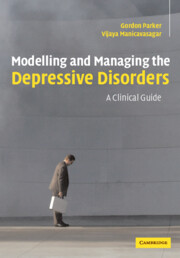Book contents
- Frontmatter
- Contents
- Acknowledgements
- Introduction
- Part I The current model for depressive disorders and its impact on clinical management
- Part II The diagnosis and management of melancholic and psychotic depression
- Part III An introduction to non-melancholic depression
- 7 Our model of non-melancholic depression
- 8 Self-esteem
- 9 Personality style and functioning
- 10 Identifying the constructs to non-melancholic depression: stress
- 11 Resilience and vulnerability
- 12 Psychological interventions for non-melancholic depression
- Part IV Modelling and managing the non-melancholic depressive disorders
- Appendix 1 The DMI-18 and the DMI-10
- Appendix 2 The CORE system of measuring psychomotor disturbance
- Appendix 3 The temperament and personality measure
- References
- Index
12 - Psychological interventions for non-melancholic depression
from Part III - An introduction to non-melancholic depression
Published online by Cambridge University Press: 17 August 2009
- Frontmatter
- Contents
- Acknowledgements
- Introduction
- Part I The current model for depressive disorders and its impact on clinical management
- Part II The diagnosis and management of melancholic and psychotic depression
- Part III An introduction to non-melancholic depression
- 7 Our model of non-melancholic depression
- 8 Self-esteem
- 9 Personality style and functioning
- 10 Identifying the constructs to non-melancholic depression: stress
- 11 Resilience and vulnerability
- 12 Psychological interventions for non-melancholic depression
- Part IV Modelling and managing the non-melancholic depressive disorders
- Appendix 1 The DMI-18 and the DMI-10
- Appendix 2 The CORE system of measuring psychomotor disturbance
- Appendix 3 The temperament and personality measure
- References
- Index
Summary
We argue that the treatment of depressive disorders should reject the ‘one size fits all’ model in favour of a model based on a matrix of differing depressive disorders and a more differentiated ‘horses for courses’ management model of treatment. The three-tiered Black Dog Institute hierarchical model for depressive classes lends itself to the development of specific targeted interventions that can be expected to lead to higher rates of treatment efficacy. Further refinements in improving treatment efficacy are also possible by varying the levels or stages of intervention within each of the depressive classes. Varying the type and level of intervention enables treatment to be delivered at a more or less intensive level depending on symptom severity, chronicity, and complexity or comorbidity with other disorders.
The match between patients' and therapists' expectations is crucial for therapy to proceed effectively. A mismatch, unless resolved, becomes a source of distraction and irritation in therapy. Although, if designed by an experienced therapist, such a mismatch can be used to advantage to shift patients' rigid expectations and may be especially useful in treating those with highly dysfunctional personality styles.
Psychological interventions for non-melancholic depression
Recent studies on the treatment of depressive disorders have predominantly focused on pharmacological or other biological therapies, most notably the efficacy of antidepressant medications. Explanations of the origins of depressive symptoms have focused on describing and categorising the various neurotransmitter pathways in the brain that may be responsible for particular physical and/or psychological phenomena.
- Type
- Chapter
- Information
- Modelling and Managing the Depressive DisordersA Clinical Guide, pp. 95 - 104Publisher: Cambridge University PressPrint publication year: 2005



